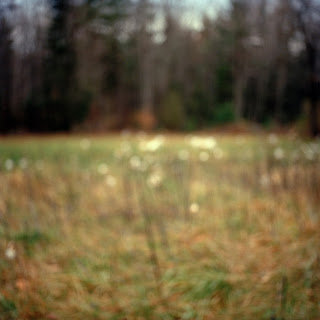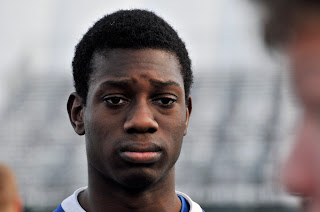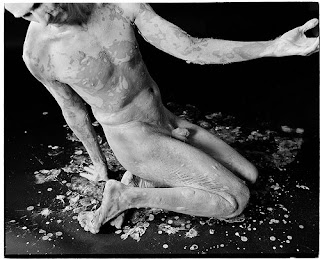Don't Burn Photos
Saturday, December 10, 2011
Lost in the Woods
With this project, I wanted to make photographs that emphasized my experience as a photographer and as a vagrant. I have never been one to feel a definite sense of connection to land and as such have always been both envious and confused by the ties I have heard others claim to a place. Upon my initial quest to investigate this connection, I ventured to places of relative quiet and repose, hoping to share in that experience. I felt lost. The more I tried the more intensely isolated and frustrated I felt, the less I could see or understand of the place I was trying to discover. I came to the conclusion that I was approaching this project from the wrong vantage, that instead of going to a place and photographing how it was intended to make me feel, I should instead use my feelings as a foundation for viewing the place I was in. The compositions presented in this work are completely intentional, my best attempt to express myself in a place and language that feels infinitely foreign.
Stephan Jahanshahi
December, 2011
Tuesday, April 12, 2011
Athletes
I had started this series as an exploration into rugby culture. I had played the game for years and wanted to better understand why I felt so drawn to these people. I soon found that the culture or community as a whole was too vast to take in at once in any meaningful way, so I narrowed my focus, both in process and concept. The singular aspect that interested me the most was the psychological space the players inhabit when given quiet moments during the game. I noticed a level of self-evaluation that perforated the athletes, no matter how they were playing they all retreated inside themselves at halftime. I found this introspection compelling, in no small part because it seemed out of character for many of these people.
As the winter closed in, the rugby season came to an end and I found it necessary to explore other communities that required the same level of introspection. I felt that physicality and competition were important aspects in creating this rigorous demand for self-evaluation, but I was curious to see how the mental demands changed as the physical demands were altered. In short it seemed too easy a leap to compare the mentalities of rugby players to football players or wrestlers, the sports invite many of the same participants and I felt that any observations would be too intuitive. I settled instead on photographing ballet dancers.
The ballet dancers I photographed were students, all of whom were between the ages of fourteen and sixteen. Already at that age they had committed themselves to being professional ballet dancers, and were in intense dance classes from one until six, Monday through Friday. I was instantly struck by the work ethic, the level of dedication each of these dancers showed. Much of each class was spent divided in groups, allowing the instructor to focus more closely on each dancer while at the same time giving the dancers breaks in the class. To my amazement these dancers did not treat their breaks as breaks. They would move out of the way of the rest of the class, find themselves in the mirror and continue practicing on their own, becoming both performer and evaluator until they were called in front of the instructor again.
This is the parallel I had discovered between these two communities; each individual within was expected to personally uphold their sense of success within the context of the game or rehearsal. Both rugby and ballet can be broken down, the individual movements in and of themselves asked of the athletes are not complicated, however they are asked to execute these movements perfectly. Both the rugby players and the ballet dancers when given a spare moment must ask themselves, “Did I achieve perfection?” in a very specific context. This is the fundamental question behind each gaze, each bowed or raised head, each furrowed brow.
Jim Telfers, considered one of the greatest rugby coaches of the modern era is famous for saying there are two kinds of rugby players; honest ones and everyone else. He goes on to say the honest rugby player wakes up and looks in the mirror everyday and says to himself “I’m going to get better, I’m going to get better, I’m going to get better.” I think this project illustrates that this commitment can be found elsewhere, that above all else it is this commitment that drives these people to the heights of their sport or art.
-Stephan Jahanshahi
April 9, 2011
Thursday, March 10, 2011
Tuesday, January 25, 2011
Studies In Clay
Artist Statement
With Studies In Clay, I sought to create an aesthetic link between physicality and time. I wanted to represent the body as a fluid entity, with images that emphasized the constant process of change and renewal we go through. I settled on using clay to represent this because it allowed the models a textile interaction, as well as giving the images a timeless quality. The selected shots are the result of collaboration between the models and myself. I contacted several dancers, a sculptor, another photographer and two live models and asked them to model in a studio setting. I explained to each model that I wanted to explore our sense of time, how we both mold ourselves and change unconsciously in a constant and physical way. They applied clay to their bodies and moved in ways that accentuated their awareness of it as it dried across their skin, making the model suddenly and intimately conscious of their physical presence during their performance in front of the camera. Once I gave the models the parameters of the performance, they were left as uninterrupted as possible to elaborate upon the concept and process on their own. Each one found a different emphasis, whether it was their desire to expand beyond the allotted space, understand the textural residence of their expressions, or approach the performance as a discovery or exploration of the moment.
Subscribe to:
Posts (Atom)


































